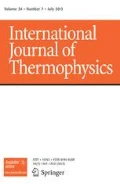Abstract
A new humidity generator that produces gas streams of known moisture content at temperatures from 85 °C to 200 °C, absolute pressures from 0.2 MPa to 1.6 MPa, and relative humidities from 10 % to 90 % has been developed. The generator produces a moist gas stream by injecting fixed-rate streams of dry gas and liquid water into a vaporizer, where the water evaporates into the gas. The gas stream passes into a re-entrant radio-frequency (RF) cavity, which serves as our reference hygrometer, and then a test chamber. The present standard uncertainty of the RF hygrometer is 0.6 %, limited by the uncertainty of literature values for the polarizability of water. Dry nitrogen gas purging the pressure transducer line also combines with the moist gas stream downstream of the test chamber and flows through one of a set of capillaries. Modulation of gas flow through the fixed flow impedance of the capillary gives a simple method for controlling pressure. Individual insulated, temperature-controlled aluminum ovens enclose each major component. A larger oven encloses these ovens and their connecting tubing. To minimize corrosion, critical components are constructed of high-nickel alloys. The small total volume (<1 L) and small flow rate (<0.5 L·min−1) reduce operational hazards from steam scalding or from gas explosion.
Similar content being viewed by others
Abbreviations
- A n :
-
Molar polarizability of nitrogen, cm3 · mol−1
- A w, B w :
-
Debye constants describing the molar polarizability of water, A w + B w/T, cm3 · mol−1
- B nn :
-
Nitrogen second virial coefficient, cm3 · mol−1
- B ww :
-
Water second virial coefficient, cm3 · mol−1
- B nw :
-
Nitrogen–water second virial coefficient, cm3 · mol−1
- B mix :
-
Second virial coefficient of the gas mixture, cm3 · mol−1
- \({\varepsilon ={\varepsilon}^{\prime}-{i}{\varepsilon}^{\prime\prime}}\) :
-
Dielectric constant
- f :
-
Resonance frequency of the RF resonator hygrometer, Hz
- L :
-
Length of capillary, m
- P :
-
Pressure, Pa
- P 1 :
-
Pressure at the capillary entrance, Pa
- P 0 :
-
Pressure at the capillary exit, Pa
- Q m :
-
Mass flow rate, kg · s−1
- r :
-
Inner radius of capillary tube, m
- R :
-
Gas constant, J · mol−1 · K−1
- s :
-
Quantity \({{({{\varepsilon}^{\prime}-1})}/{( {{\varepsilon }^{\prime}+2})}}\)
- T :
-
Temperature, K
- T c :
-
Temperature of capillary, K
- x w :
-
Mole fraction of water
- η :
-
Viscosity, Pa · s
References
Mawardi A., Yang F., Pitchumani R.: J. Fuel Cell Sci. Technol. 2, 121 (2005)
Wagner W., Pruss A.: J. Phys. Chem. Ref. Data 31, 387 (2002)
P.H. Huang, D.C. Ripple, M.R. Moldover, G.E. Scace, A Reference Standard for Measuring Humidity of Air Using a Re-entrant Radio Frequency Resonator, in Proceeedings 5th International Symposium on Humidity and Moisture (ISHM, Rio de Janeiro, 2006)
Cheremisinoff N.P.: Fluid Flow: Pumps, Pipes and Channels. Ann Arbor Science, Ann Arbor (1981)
Tritton D.J.: Physical Fluid Dynamics, 2nd edn. Oxford University Press, Oxford (1988)
Buckingham A.D., Raab R.E.: Trans. Faraday Soc. 54, 623 (1958)
Harvey A.H., Lemmon E.W.: Int. J. Thermophys. 26, 31 (2005)
Moldover M.R., Buckley T.J.: Int. J. Thermophys. 22, 859 (2001)
Birnbaum G., Chatterjee S.K.: J. Appl. Phys. 23, 220 (1952)
Dymond J.H., Smith E.B.: The Virial Coefficients of Pure Gases and Mixtures, A Critical Compilation. Oxford University Press, Oxford (1980)
Harvey A.H., Lemmon E.W.: J. Phys. Chem. Ref. Data 33, 369 (2004)
P.E. Huang, A.H. Harvey, NIST, private communication
Author information
Authors and Affiliations
Corresponding author
Additional information
Official contribution of the National Institute of Standards and Technology; not subject to copyright in the United States.
Rights and permissions
About this article
Cite this article
Vega-Maza, D., Miller, W.W., Ripple, D.C. et al. A Humidity Generator for Temperatures up to 200 °C and Pressures up to 1.6 MPa. Int J Thermophys 33, 1477–1487 (2012). https://doi.org/10.1007/s10765-010-0838-1
Received:
Accepted:
Published:
Issue Date:
DOI: https://doi.org/10.1007/s10765-010-0838-1




